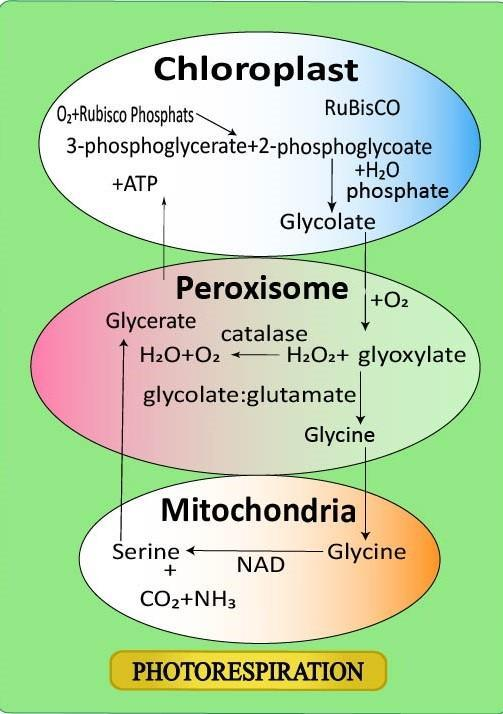
Why is photorespiration also called
Answer
492.6k+ views
1 likes
Hint: Photorespiration is a reverse process as compared to photosynthesis. It involves the uptake of
Complete step by step answer:
Photorespiration is also called the

This process of photorespiration converts the sugar phosphates back to carbon dioxide. It is initiated by the oxygenation of RuBP (Ribulose 1,5-bisphosphate) (an organic substance that is involved in photosynthesis). The combination of gas with RuBP yields only one molecule of PGA and one molecule of a two-carbon acid, phosphoglycolate, which is subsequently converted in part to carbon dioxide.
The relative concentrations of oxygen and carbon dioxide as well as the leaf temperature, within the chloroplasts, determine whether oxygenation or carboxylation is favored. Phosphoglycolate formed by the fixation of oxygen is recycled to the Calvin cycle.
Note:
- In early 1920, Otto Warburg observed that oxygen inhibits photosynthesis. This phenomenon, originally known as the “Warburg effect,” was later recognized as the light-dependent release of carbon dioxide by photosynthetic organisms, or photorespiration.
- Photorespiration is a wasteful process because no energy-rich compound is produced and loss of carbon takes place during such a process. This process has a significant impact on
Complete step by step answer:
Photorespiration is also called the

This process of photorespiration converts the sugar phosphates back to carbon dioxide. It is initiated by the oxygenation of RuBP (Ribulose 1,5-bisphosphate) (an organic substance that is involved in photosynthesis). The combination of gas with RuBP yields only one molecule of PGA and one molecule of a two-carbon acid, phosphoglycolate, which is subsequently converted in part to carbon dioxide.
The relative concentrations of oxygen and carbon dioxide as well as the leaf temperature, within the chloroplasts, determine whether oxygenation or carboxylation is favored. Phosphoglycolate formed by the fixation of oxygen is recycled to the Calvin cycle.
Note:
- In early 1920, Otto Warburg observed that oxygen inhibits photosynthesis. This phenomenon, originally known as the “Warburg effect,” was later recognized as the light-dependent release of carbon dioxide by photosynthetic organisms, or photorespiration.
- Photorespiration is a wasteful process because no energy-rich compound is produced and loss of carbon takes place during such a process. This process has a significant impact on
Recently Updated Pages
Express the following as a fraction and simplify a class 7 maths CBSE

The length and width of a rectangle are in ratio of class 7 maths CBSE

The ratio of the income to the expenditure of a family class 7 maths CBSE

How do you write 025 million in scientific notatio class 7 maths CBSE

How do you convert 295 meters per second to kilometers class 7 maths CBSE

Write the following in Roman numerals 25819 class 7 maths CBSE

Trending doubts
State and prove Bernoullis theorem class 11 physics CBSE

What are Quantum numbers Explain the quantum number class 11 chemistry CBSE

Write the differences between monocot plants and dicot class 11 biology CBSE

1 ton equals to A 100 kg B 1000 kg C 10 kg D 10000 class 11 physics CBSE

State the laws of reflection of light

One Metric ton is equal to kg A 10000 B 1000 C 100 class 11 physics CBSE




